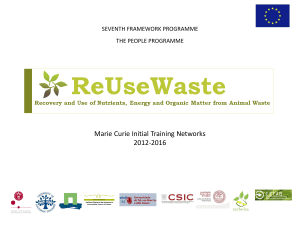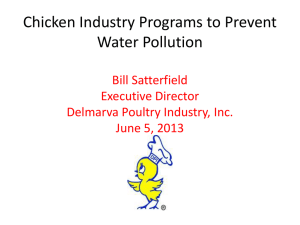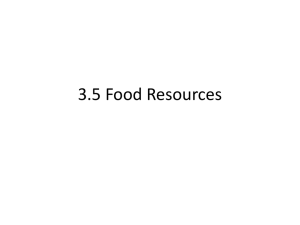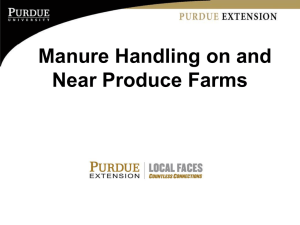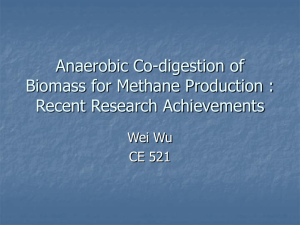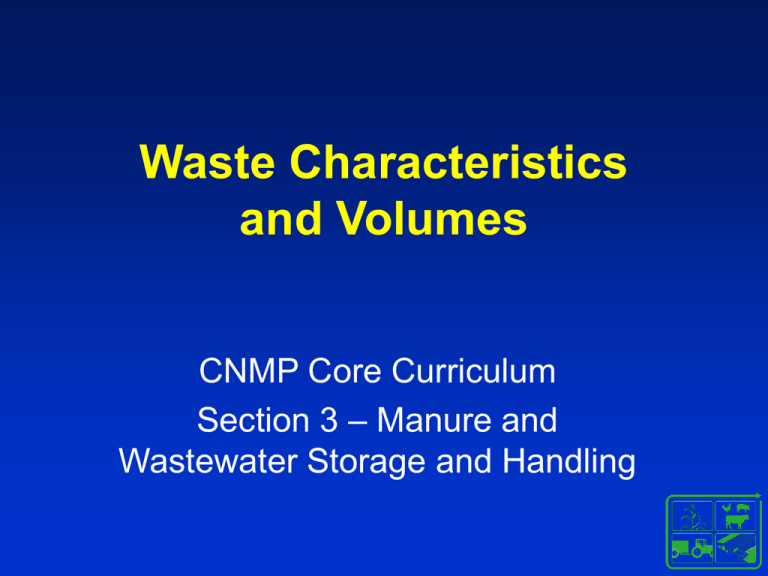
Waste Characteristics
and Volumes
CNMP Core Curriculum
Section 3 – Manure and
Wastewater Storage and Handling
CNMP Development
Core Training Curriculum
These course materials have been developed as a
cooperative effort between five land-grant universities
and The Natural Resources Conservation Service.
Copyright Information
Ames, Iowa 50011, (515) 294-4111.
Copyright © 1995-2006, Iowa State University
of Science and Technology. All rights reserved.
To be discussed:
•
•
•
•
Manure Characteristics
Manure Volume Estimation Methods
Manure Nutrient Estimation Methods
Additional Waste Volumes
Manure Characteristics
• How would you characterize manure?
– Qualitative
• Odor
– Quantitative
• Physical
Properties
• Chemical
Properties
• Biological
Properties
Manure Characteristics
– Book Values
• ASAE D384.2
– Under Revision
• MWPS 18-1
• NRCS Chapter 4
AWMFH
– On-farm testing /
database
MWPS 18-1
NRCS Chapter 4 AWMFH
ASAE D384.2
The Magical Animal Unit
• An animal unit is 1,000 pounds of any type
of animal
– One 1,400 pound dairy cow: 1.4 AU
– One 200 pound pig: 0.2 AU
– One 7 pound chicken: 0.007 AU
• Calculation
# of animals* animal weight (lbs)
1,000 lb/AU
Manure Volume Estimation
• NRCS
– 1.30 ft3/day
• 175 Lactating Cows
– 175*1300lb/1000lb/AU
= 228 AU
– 228 AU * 1.3 ft3/day
= 296 ft3/day manure
produced
• Is all of the manure
stored in the same
location?
NRCS
Learning Exercise
Calculate Volume Produced
• Using the information provided, calculate
the annual volume of manure produced by
the example herd.
• 175 Milking Cows
(1300 lbs)
• 14 Dry Cows
(1300 lbs)
• 55 Heifers
(1000 lbs)
• 25 Young Heifers
(500 lbs)
• 25 Calves
(200 lbs)
Volume Numbers
Number
Weight
AU
MWPS
ASAE
NRCS
ft3/day
ft3/day
ft3/day/AU
ft3/day
ft3/day/AU
ft3/day
Milking Cows
175
1300
228
1.94
340
1.39
316
1.30
296
Dry Cows
14
1300
18
1.94
27
1.39
25
1.30
24
Heifers
55
1000
55
1.39
76
1.39
76
1.30
72
Young Heifers
25
500
13
0.69
17
1.39
17
1.30
16
Calves
25
200
5
0.35
9
1.39
7
1.30
7
Total
294
318
469
441
Volume of Manure Generated
500.0
ft3/day
400.0
300.0
200.0
100.0
0.0
MWPS
ASAE
Data Source
NRCS
414
ASAE D384.2 – Manure Production and
Characteristics
• ASAE Diet based manure characteristics
– New developments
• Genotype
• Feeding practices (ie. split sex)
• Diet modification (ie. phytase)
– Nutrient management planning needs
– Existing literature developed prior to these
changes
Revision of ASAE D384.1 – Manure
Production and Characteristics
• Work groups develop excretion model
based on dietary inputs
– Total Solids
– Nitrogen
– Phosphorus
• Diet based equations
for calculated
manure characteristics
Table 4-3
Material
Bedding
Unit weights of common
bedding materials
Loose
• Types of Bedding
Chopped
lb/ft3
Legume hay
4.25
6.50
Nonlegume hay
4.00
6.00
Straw
2.50
7.00
Wood shavings
9.00
Sawdust
12.00
Soil
75.00
Sand
105.00
Ground limestone
95.00
Table 4-4
Straw
Compost
Sand
Wood Shavings
Limestone
Shredded Newsprint
• Porous Bedding
– Design Volume is
50% Total Volume
Daily bedding requirements for dairy cattle
Material
Barn Type
Stanchion Stall
Freestall
Loose Housing
lb/day/1000 lbs
Loose hay or straw
5.4
Chopped hay or straw
5.70
9.3
2.70
Shavings or sawdust
3.1
Sand, soil, or limestone
1.50
11
• Account for
wastewater entering
pore space
• NonPorous Bedding
– Design Volume =
Total Volume
Additional Waste Volumes
• Wasted Feed
– Increase solids and nutrients content by 4% for
every 1% feed waste over 5%
• Wash Water
– Washing Milking Parlor
– Washing Cattle Trucks
– Calf Bottles, etc.
• Flush Water
– Recycled water
Moisture Content
• Total Solids (TS)
– All solids in manure
• Sample dried @ 105º C
• Volatile Solids (VS)
– Organic solids
• Combust @ 600º C
• Water Content
Wwater = Wmanure – WTS
Relative Consistency
• Manure is stored and
handled
–
–
–
–
–
Type of animal
Animal housing
Manure collection
Manure treatment
Manure application
Manure Nutrient Estimation
• Manure Testing
– Preferred Method
• REPRESENTATIVE
SAMPLE
• Book Values
• ASAE D384.2
• MWPS 18-1
• NRCS Chapter 4
AWMFH
Learning Exercise
Calculate N, P205 and K20
• Calculate the total pounds of N,
P205 and K20 produced in a year.
• 175 Milking Cows
(1300 lbs)
NRCS Calculations
175 MilkingCow s * 1300 lbs *
175 MilkingCow s * 1300 lbs *
1 AU
1000 lbs
*
1 AU
*
0 . 45 lbN
1000 lbs
AU * day
0 . 07 lbP
* 365 days
AU * day
* 365 days
37 ,367 lbN
year
5 ,813 lbP
year
*
2 . 288 lbP 2 0 5
lbP
13 , 299 lbP 2 0 5
year
N, P205 Calculations
Number
Weight
AU
NRCS N
NRCS P
lb/day/AU
lb/day
lb/day/AU
lb/day
Milking Cows
175
1300
227.5
0.45
102.4
0.07
15.9
Dry Cows
25
1300
32.5
0.36
11.7
0.05
1.6
Young Replacement Cows
25
350
8.8
0.31
2.7
0.04
0.4
Replacement Cows
50
900
45.0
0.31
14.0
0.04
1.8
Total
275
314
131
N, P205 Produced
60,000
52,159
51,533
50,000
47,719
40,000
30,000
20,988
N lb/year
24,630
16,452
20,000
10,000
0
MWPS
ASAE
Data Source
NRCS
P205 lb/year
20
Conclusion
• Book Values
– Questions on estimating volume and nutrient
content?
• On-Farm Testing
– Develop a database



